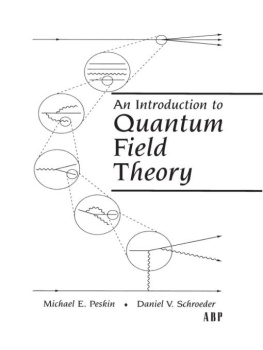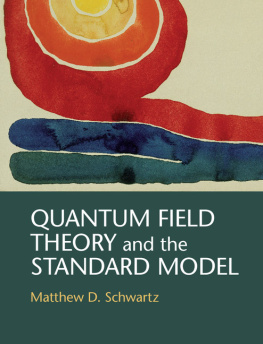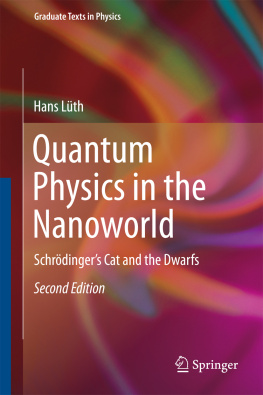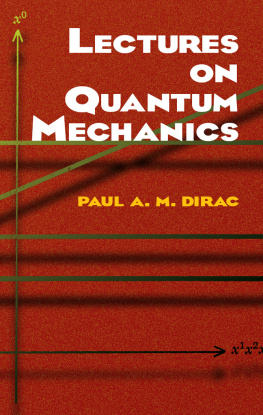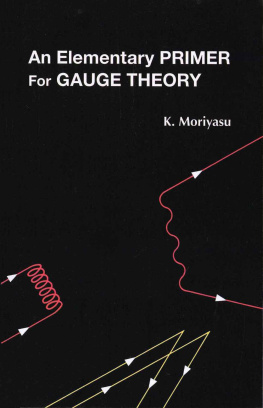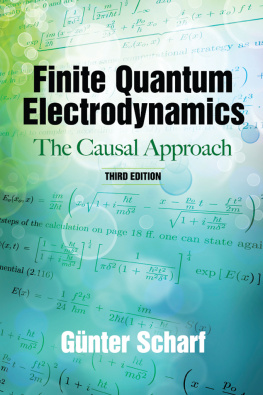Table of Contents
Preface
Quantum field theory is a set of ideas and tools that combines three of the major themes of modern physics: the quantum theory, the field concept, and the principle of relativity. Today, most working physicists need to know some quantum field theory, and many others are curious about it. The theory underlies modern elementary particle physics, and supplies essential tools to nuclear physics, atomic physics, condensed matter physics, and astrophysics. In addition, quantum field theory has led to new bridges between physics and mathematics.
One might think that a subject of such power and widespread application would be complex and difficult. In fact, the central concepts and techniques of quantum field theory are quite simple and intuitive. This is especially true of the many pictorial tools (Feynman diagrams, renormalization group flows, and spaces of symmetry transformations) that are routinely used by quantum field theorists. Admittedly, these tools take time to learn, and tying the subject together with rigorous proofs can become extremely technical. Nevertheless, we feel that the basic concepts and tools of quantum field theory can be made accessible to all physicists, not just an elite group of experts.
A number of earlier books have succeeded in making parts of this subject accessible to students. The best known of these is the two-volume text written in the 1960s by our Stanford colleagues Bjorken and Drell. In our opinion, their text contains an ideal mixture of abstract formalism, intuitive explanations, and practical calculations, all presented with great care and clarity. Since the 1960s, however, the subject of quantum field theory has developed enormously, both in its conceptual framework (the renormalization group, new types of symmetries) and in its areas of application (critical exponents in condensed matter systems, the standard model of elementary particle physics). It is long overdue that a textbook of quantum field theory should appear that provides a complete survey of the subject, including these newer developments, yet still offers the same accessibility and depth of treatment as Bjorken and Drell. We have written this book with that goal in mind.
An Outline of the Book
This textbook is composed of three major sections. The first is mainly concerned with the quantum theory of electromagnetism, which provided the first example of a quantum field theory with direct experimental applications. The third part of the book is mainly concerned with the particular quantum field theories that appear in the standard model of particle interactions. The second part of the book is a bridge between these two subjects; it is intended to introduce some of the very deep concepts of quantum field theory in a context that is as straightforward as possible.
Part I begins with the study of fields with linear equations of motion, that is, fields without interactions. Here we explore the combined implications of quantum mechanics and special relativity, and we learn how particles arise as the quantized excitations of fields. We then introduce interactions among these particles and develop a systematic method of accounting for their effects. After this introduction, we carry out explicit computations in the quantum theory of electromagnetism. These illustrate both the special features of the behavior of electrons and photons and some general aspects of the behavior of interacting quantum fields.
In several of the calculations in Part I, naive methods lead to infinite results. The appearance of infinities is a well-known feature of quantum field theory. At times, it has been offered as evidence for the inconsistency of quantum field theory (though a similar argument could be made against the classical electrodynamics of point particles). For a long time, it was thought sufficient to organize calculations in such a way that no infinities appear in quantities that can be compared directly to experiment. However, one of the major insights of the more recent developments is that these formal infinities actually contain important information that can be used to predict the qualitative behavior of a system. In Part II of the book, we develop this theory of infinities systematically. The development makes use of an analogy between quantum-mechanical and thermal fluctuations, which thus becomes a bridge between quantum field theory and statistical mechanics. At the end of Part II we discuss applications of quantum field theory to the theory of phase transitions in condensed matter systems.
Part III deals with the generalizations of quantum electrodynamics that have led to successful models of the forces between elementary particles. To derive these generalizations, we first analyze and generalize the fundamental symmetry of electrodynamics, then work out the consequences of quantizing a theory with this generalized symmetry. This analysis leads to intricate and quite nontrivial applications of the concepts introduced earlier. We conclude Part III with a presentation of the standard model of particle physics and a discussion of some of its experimental tests.
The Epilogue to the book discusses qualitatively the frontier areas of research in quantum field theory and gives references that can guide a student to the next level of study.
Where a choice of viewpoints is possible, we have generally chosen to explain ideas in language appropriate to the applications to elementary particle physics. This choice reflects our background and research interests. It also reflects our strongly held opinion, even in this age of intellectual relativism, that there is something special about unraveling the behavior of Nature at the deepest possible level. We are proud to take as our subject the structure of the fundamental interactions, and we hope to convey to the reader the grandeur and continuing vitality of this pursuit.
How to Use This Book
This book is an introduction to quantum field theory. By this we mean, first and foremost, that we assume no prior knowledge of the subject on the part of the reader. The level of this book should be appropriate for students taking their first course in quantum field theory, typically during the second year of graduate school at universities in the United States. We assume that the student has completed graduate-level courses in classical mechanics, classical electrodynamics, and quantum mechanics. In Part II we also assume some knowledge of statistical mechanics. It is not necessary to have mastered every topic covered in these courses, however. Crucially important prerequisites include the Lagrangian and Hamiltonian formulations of dynamics, the relativistic formulation of electromagnetism using tensor notation, the quantization of the harmonic oscillator using ladder operators, and the theory of scattering in nonrelativistic quantum mechanics. Mathematical prerequisites include an understanding of the rotation group as applied to the quantum mechanics of spin, and some facility with contour integration in the complex plane.
Despite being an introduction, this book is rather lengthy. To some extent, this is due to the large number of explicit calculations and worked examples in the text. We must admit, however, that the total number of topics covered is also quite large. Even students specializing in elementary particle theory will find that their first research projects require only a part of this material, together with additional, specialized topics that must be gleaned from the research literature. Still, we feel that students who want to become experts in elementary particle theory, and to fully understand its unified view of the fundamental interactions, should master every topic in this book. Students whose main interest is in other fields of physics, or in particle experimentation, may opt for a much shorter introduction, omitting several chapters.

